
These following images are different avian species recorded in Arkansas. Along with the image will be details for the species.
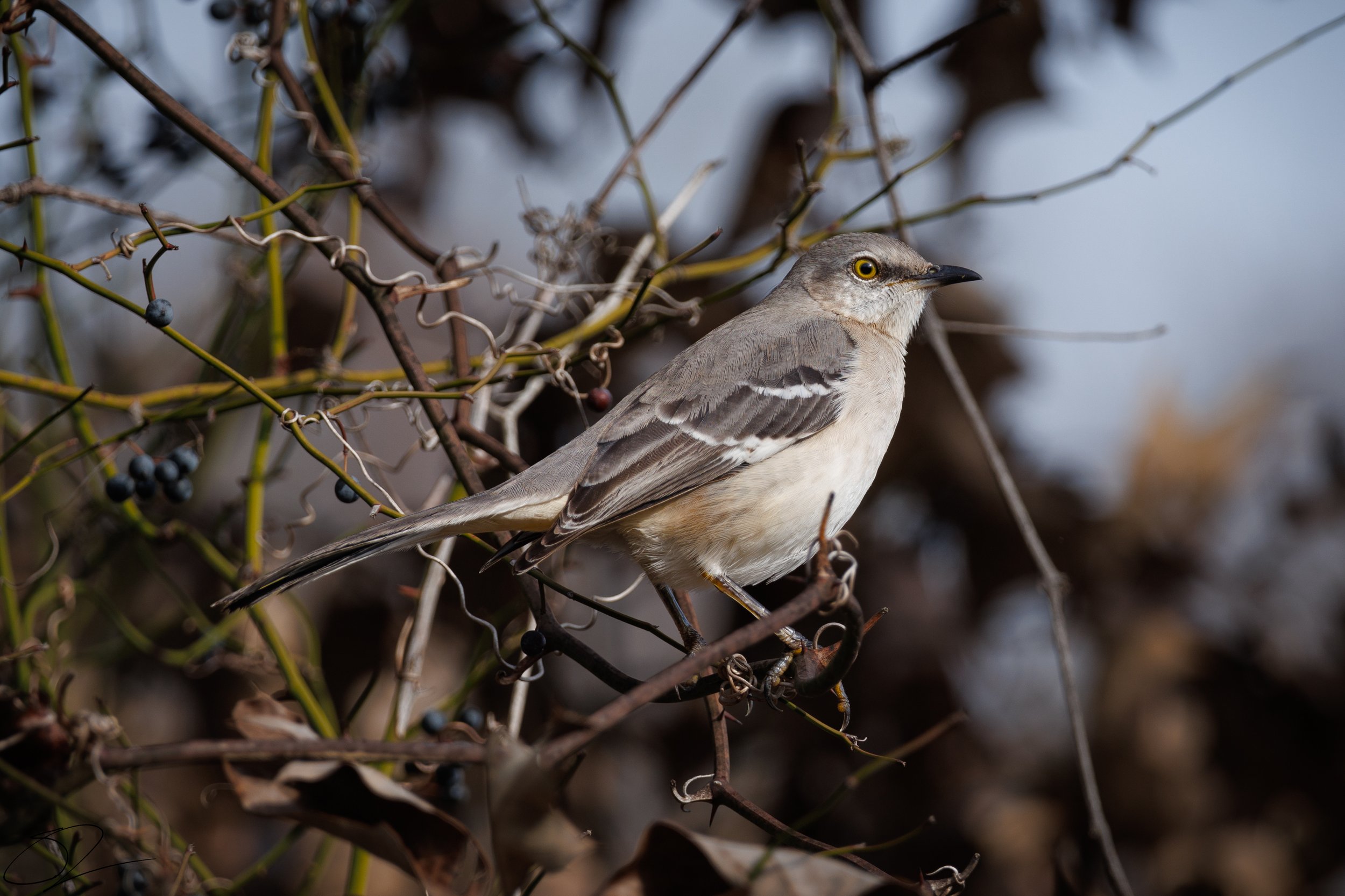
Northern Mockingbird ~ Up first is the Northern Mockingbird. Arkansas' State bird since 1929, (Mimus polyglottos) is a highly adaptable and intelligent songbird found throughout North and Central America. Known for its exceptional ability to mimic the songs of other birds, animals, and even mechanical sounds, it can replicate up to 200 different sounds. The Northern Mockingbird has grayish plumage with white wing patches and a white underside. It is often seen perched on fences, tree branches, or power lines, singing a variety of calls, especially at dawn and dusk. These birds are territorial and aggressive when defending their nests, which are built in dense shrubs or trees. They feed on insects, fruits, and berries, playing an important role in controlling insect populations.
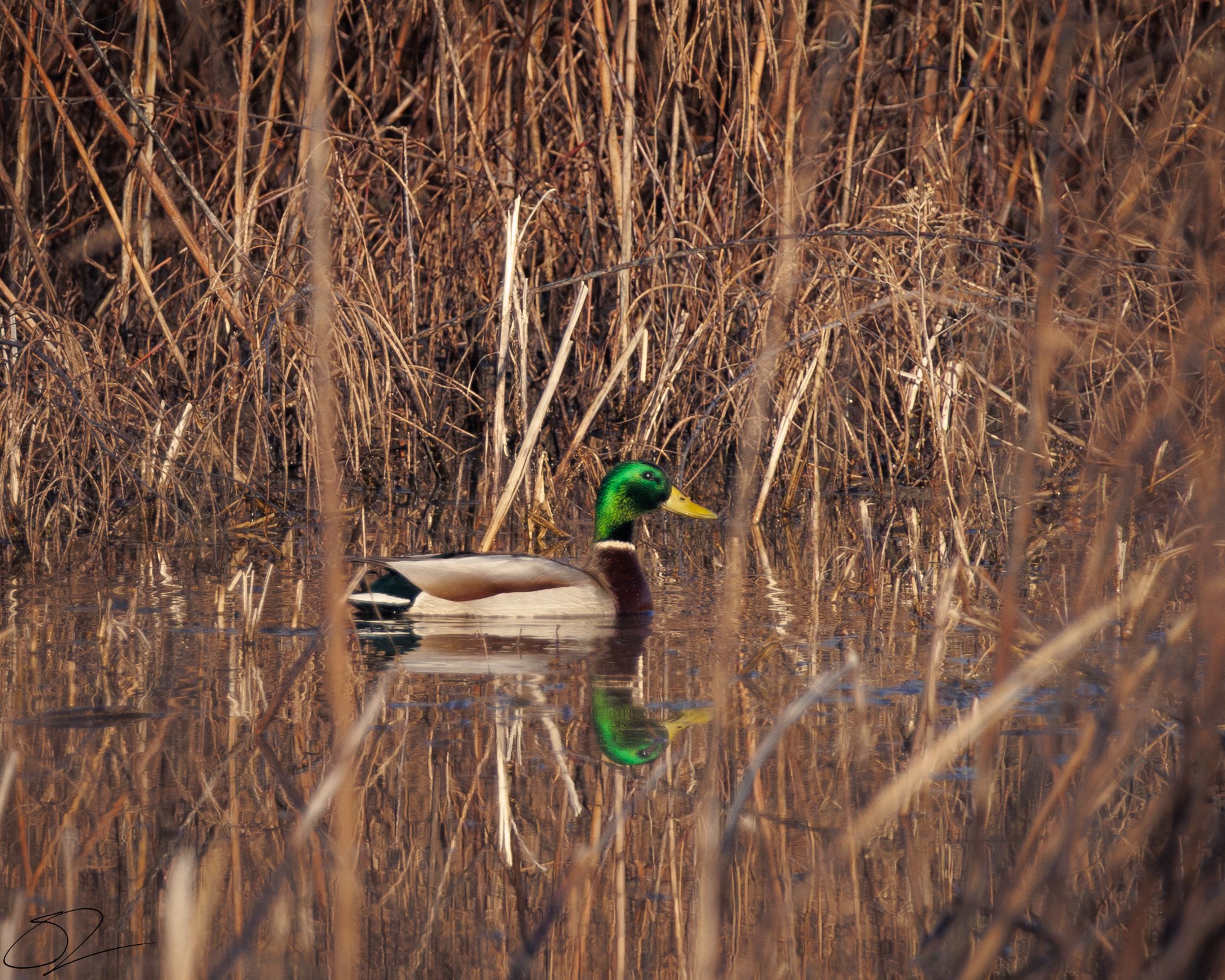
Mallard ~ (Anas platyrhynchos Large duck, extensively seen most places that has water. The males are characterized by a vibrant green head, yellow bill, chestnut chest, and gray body. The females are harder to distinguish between Black, Mottled and Mexican ducks. Those species are usually darker, and if you can see the blue wing bar with leading and following white then you have a mallard.

American Robin ~ (Turdus migratorius) North American songbird known for its grayish-brown back, vibrant orange-red breast, and cheerful song. Measuring 9-11 inches in length with a wingspan of 12-16 inches, it thrives in forests, gardens, and urban areas. Robins feed on insects, worms, and berries, often seen hopping on lawns while foraging. They build cup-shaped nests from mud and grass, usually in trees or on ledges. While some remain year-round in warmer regions, many migrate south for the winter, making them a well-known symbol of spring's arrival.

Belted Kingfisher ~ (Megaceryle alcyon) A striking, medium-sized bird known for its shaggy crest, blue-gray plumage, and distinctive white collar. Males have a single blue-gray band across the chest, while females feature an additional rusty band. Commonly found near rivers, lakes, and coastal waters across North America, Belted Kingfishers are expert fishers, hovering over water before diving headfirst to catch prey. They nest in burrows dug into sandy banks and are often spotted perched on branches scanning for food. Their loud, rattling call is a familiar sound in their habitats.

Dark-Eyed Junco ~ (Junco hyemalis) The Dark-eyed Junco is a small, sparrow-like bird commonly found across North America, especially in forests, fields, and backyards. It has a distinctive gray or brown plumage with a white belly and outer tail feathers that flash in flight. Juncos are ground foragers, feeding on seeds, insects, and berries. They are often called "snowbirds" because their populations migrate south in winter, making them a familiar sight during colder months. With their soft trilling calls and energetic hopping, dark-eyed juncos add lively movement to their habitats year-round.

Eastern Kingbird ~ (Tyrannus tyrannus) is a medium-sized, black-and-white songbird known for its bold behavior and aerial hunting skills. It has a dark gray to black upper body, a white underside, and a distinctive white-tipped tail. Found across North America in open fields, orchards, and near water, Eastern Kingbirds primarily feed on flying insects, often catching them mid-air. They are highly territorial and will aggressively defend their nesting areas, even chasing away much larger birds. During migration to South America, their diet shifts to include more fruit. Their sharp, chattering calls and fearless nature make them a standout species in their habitat.

Blue-winged Teal ~ (Spatula discors) is a small dabbling duck found in wetlands, marshes, and shallow ponds across North America. Males have a distinctive blue-gray head with a white crescent in front of the eye, while both sexes display blue wing patches visible in flight. They primarily feed on aquatic plants, seeds, and small invertebrates by dabbling at the water’s surface. Blue-winged Teals are among the first ducks to migrate south in the fall, traveling as far as South America for the winter. Their swift flight and preference for shallow, vegetated waters make them a common sight in wetland habitats.
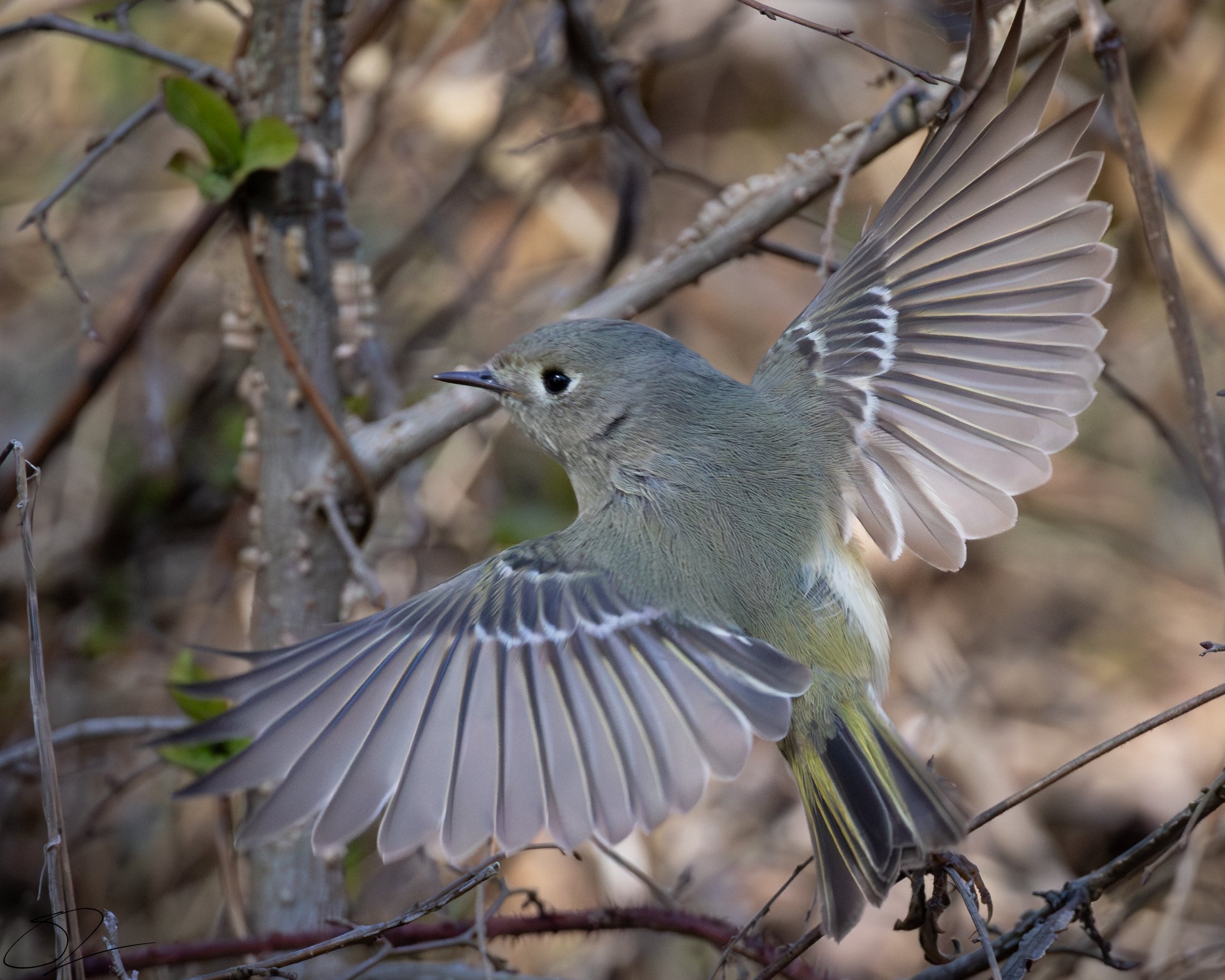
Ruby-crowned Kinglet ~ (Corthylio calendula) is a tiny, energetic songbird found in forests, thickets, and shrublands across North America. It has olive-green plumage, a white eye ring, and, in males, a hidden bright red crown that is displayed when excited or agitated. These birds are constantly flitting and flicking their wings as they forage for insects, spiders, and small berries. Despite their small size, they have a loud and complex song. Ruby-crowned Kinglets migrate seasonally, breeding in northern forests and wintering in the southern U.S. and Central America, where they remain active and vocal year-round.
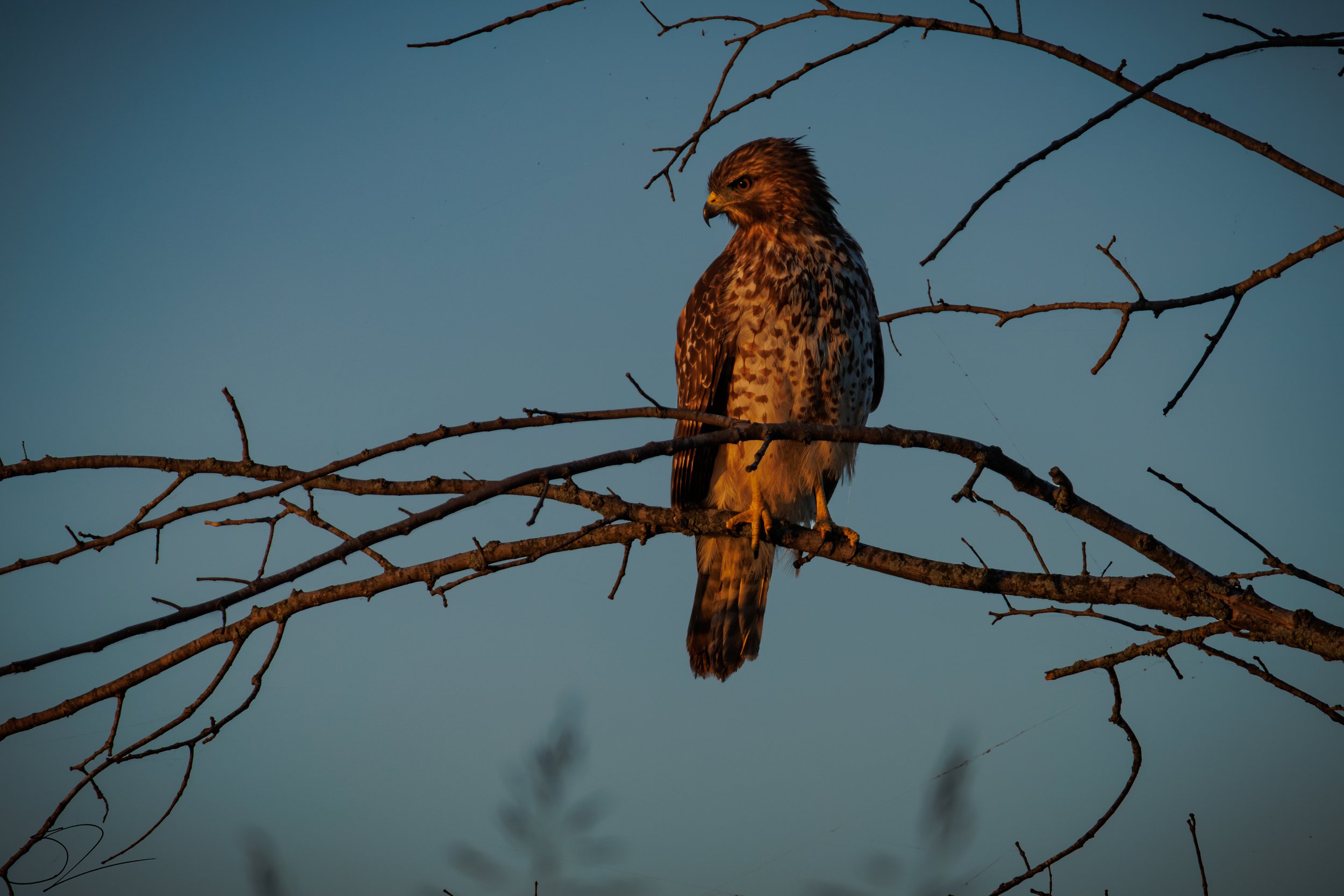
Red-shouldered Hawk ~ (Buteo lineatus) is a medium-sized bird of prey found in forests, wetlands, and wooded suburbs across eastern and western North America. It has a striking appearance with reddish-brown shoulders, a barred chest, and black-and-white checkered wings. Known for its piercing, high-pitched call, this hawk primarily hunts small mammals, reptiles, and amphibians, often from a perch. Red-shouldered Hawks are skilled fliers and use both soaring and ambush techniques to capture prey. They are monogamous and return to the same nesting sites year after year, playing an important role in maintaining ecological balance in their habitats.

Palm Warbler ~ (Setophaga palmarum) is a small songbird known for its constant tail bobbing and preference for open habitats such as bogs, scrublands, and forest edges. It has a brownish-olive body, a yellow underside, and a distinctive rusty-red cap, especially in breeding males. Despite its name, it is more commonly found in northern boreal forests during breeding season and migrates to the southeastern U.S. and the Caribbean for winter. Palm Warblers primarily feed on insects, often foraging on the ground rather than in trees like many other warblers. Their active behavior and distinctive tail movements make them easy to recognize in the field.

American White Pelican ~ (Pelecanus erythrorhynchos) is a large, striking waterbird known for its bright white plumage, black-tipped wings, and massive orange bill. With a wingspan of up to 9 feet, it is one of North America’s largest flying birds. Unlike Brown Pelicans, it does not dive for fish but instead catches prey cooperatively by herding fish into shallow waters. Found on lakes, rivers, and coastal wetlands, it breeds in colonies on inland lakes and migrates to southern coasts for winter. Despite their size, American White Pelicans are graceful in flight, often soaring in synchronized formations.

Northern Cardinal ~ (Cardinalis cardinalis) is a striking songbird known for its bright red plumage in males and warm brown tones with red accents in females. Both sexes have a distinctive crest and a black mask around their thick, orange beak. Found in woodlands, gardens, and backyards across the eastern and central U.S., they are year-round residents and do not migrate. Their diet consists of seeds, fruits, and insects. Cardinals are known for their rich, melodic songs, which both males and females sing. Their vibrant color and cheerful calls make them a beloved backyard bird.

Golden-crowned Kinglet ~ (Regulus satrapa) is a tiny, energetic songbird found in coniferous forests across North America. It has olive-green plumage, a bold black-and-white facial pattern, and a bright yellow or orange crown stripe, which is more vibrant in males. These birds are constantly active, flitting through trees in search of insects and spiders. Despite their small size, they are hardy and can survive harsh winter conditions. Their high-pitched calls and rapid movements make them a challenge to spot but a delight to observe.
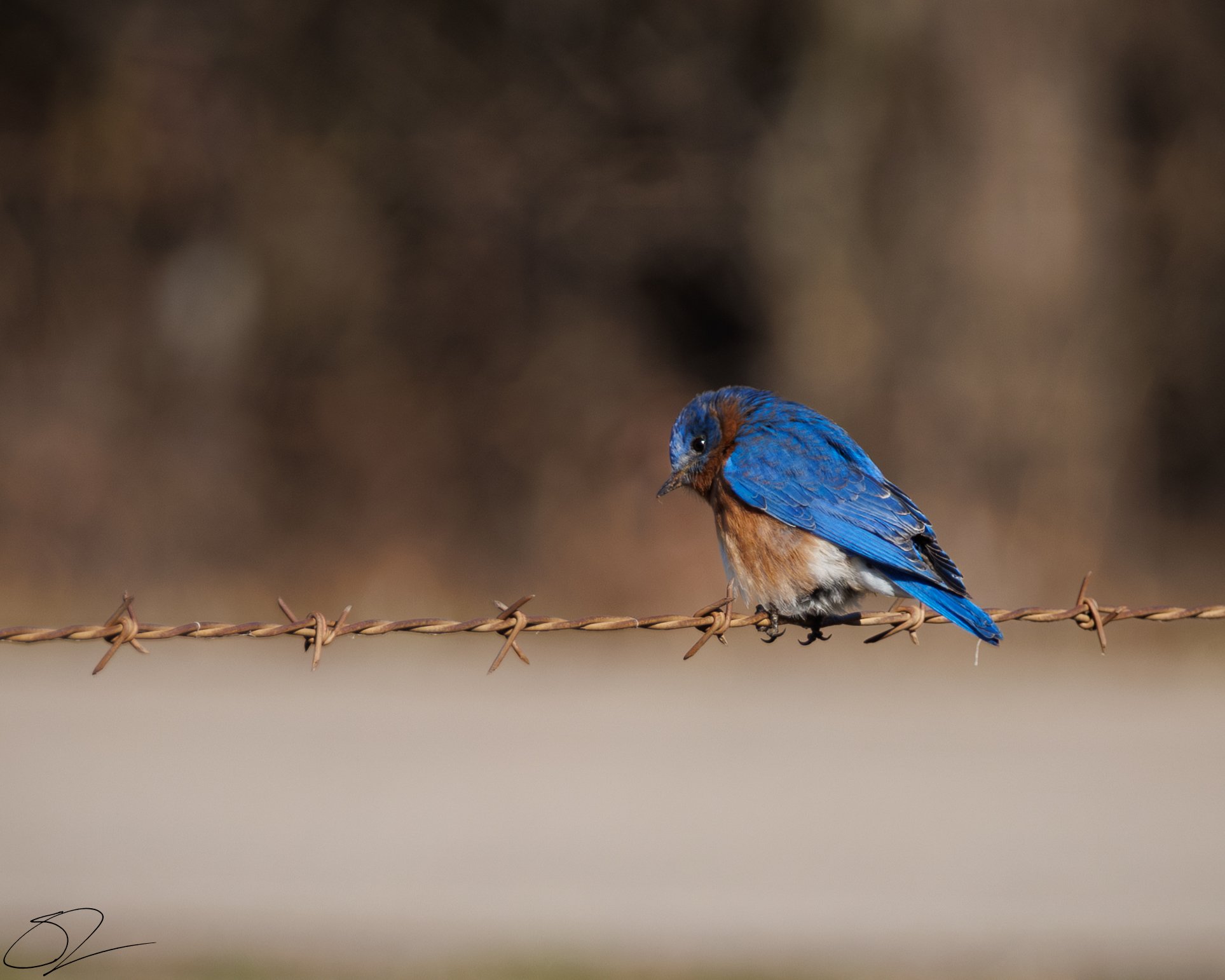
Eastern Bluebird ~ (Sialia sialis) is a small, brightly colored thrush found in open woodlands, meadows, and farmlands across eastern North America. Males have vivid blue plumage with a rusty-orange chest, while females are more muted with grayish-blue tones. They primarily feed on insects, berries, and fruits, often hunting from perches before swooping to catch prey. Eastern Bluebirds are cavity nesters, frequently using tree holes or nest boxes. Their gentle warbling song and striking colors make them a favorite among birdwatchers, and their populations have rebounded thanks to conservation efforts and nest box programs.

White-crowned Sparrow ~ (Zonotrichia leucophrys) is a medium-sized songbird known for its bold black-and-white striped head, gray body, and pink or yellowish bill. Found across North America, it breeds in northern tundra and mountainous regions, migrating south to fields, shrubby areas, and backyards during winter. These sparrows forage on the ground, feeding on seeds, insects, and berries. Their clear, whistling song varies by region and is learned from nearby birds. White-crowned Sparrows are hardy migrants, traveling long distances between breeding and wintering grounds each year.

American Coot ~ (Fulica americana) is a medium-sized waterbird commonly found in freshwater lakes, ponds, and marshes across North America. Unlike ducks, it has a dark gray body, a white, chicken-like bill, and lobed, rather than webbed, feet that help it swim efficiently. Coots are omnivorous, feeding on aquatic plants, insects, and small fish. They are strong swimmers and divers but are awkward fliers, often requiring a long, running takeoff across the water. Social and often seen in large flocks, American Coots are known for their noisy, grunting calls and aggressive behavior, especially during breeding season.

Wood Duck ~ (Aix sponsa) a colorful and striking waterfowl species found in wooded swamps, marshes, and riverbanks across North America. Males have iridescent green and purple heads with bold white markings, while females are more subdued with brown plumage and a distinctive white eye-ring. Unlike most ducks, Wood Ducks nest in tree cavities near water, and ducklings leap from their nests soon after hatching. They feed on seeds, aquatic plants, and small invertebrates. Thanks to conservation efforts and nest box programs, their populations have rebounded after historical declines. Their unique beauty and agility in flight make them a favorite among bird watchers.

Northern Harrier ~ (Circus hudsonius) is a medium-sized hawk known for its low, gliding flight over grasslands and marshes. It has a slender body, long wings, and a distinctive white rump patch visible in flight. Males are gray with black wingtips, while females and juveniles are brown with streaked underparts. Unlike most hawks, Northern Harriers rely on both keen eyesight and sharp hearing to hunt, using their owl-like facial disc to detect small mammals and birds. They build nests on the ground in dense vegetation and are often seen patrolling open landscapes with their characteristic V-shaped wing posture.

Black Vulture ~ (Coragyps atratus) is a large scavenging bird found in the southeastern United States, Central, and South America. It has black plumage, a short, square tail, and a featherless grayish-black head, which helps keep it clean while feeding. Unlike the Turkey Vulture, Black Vultures rely more on sight than smell to find food, often following other scavengers to carrion. They soar with broad wings, showing distinctive white patches near the wingtips. Social birds, they roost in large groups and are known for their strong family bonds. Though often seen near roadkill and landfills, they play a vital role in cleaning up ecosystems.

Female Purple Finch ~ (Haemorhous purpureus) is a small, seed-eating songbird found in forests, gardens, and feeders across North America. Males have a rosy-red wash over their head, chest, and back, while females are brown and streaked with bold facial markings. Often confused with the House Finch, Purple Finches have a more vibrant raspberry-red hue and a chunkier body. They primarily feed on seeds, berries, and insects, using their strong beaks to crack open tough shells. Known for their rich, warbling song, Purple Finches migrate seasonally, breeding in northern forests and wintering in the southern U.S.

Greater Roadrunner ~ (Geococcyx californianus) is a fast-running, ground-dwelling bird native to the southwestern United States and Mexico. It has a long tail, streaked brown and white plumage, and a distinctive crest. Known for its speed, it can run up to 20 mph, using its strong legs to chase down prey, which includes insects, lizards, snakes, and even small birds. Unlike most birds, it can thermoregulate by sunbathing with its back feathers spread. Though capable of flight, it prefers to stay on the ground, often seen darting across roads or through desert scrub. The roadrunner is famous in folklore and pop culture for its speed and resilience.

Carolina Chickadee ~ (Poecile carolinensis) is a small, lively songbird found in forests, parks, and backyards across the southeastern United States. It has a black cap and bib, white cheeks, and soft gray plumage on its back and wings. Similar in appearance to the Black-capped Chickadee, it is distinguished by its range and slightly faster, higher-pitched calls. Carolina Chickadees are curious and social, often forming mixed flocks with other songbirds in winter. They primarily feed on insects, seeds, and berries, frequently visiting bird feeders. Their familiar “chick-a-dee-dee-dee” call makes them a favorite among birdwatchers.

White-throated Sparrow ~ (Zonotrichia albicollis) is a medium-sized songbird found in forests, shrubby areas, and backyards across North America, especially during migration and winter. It has a distinctive white throat patch, yellow spots in front of its eyes, and either black-and-white or tan-and-brown striped head patterns. These sparrows forage on the ground for seeds, insects, and berries, often scratching through leaf litter. Their clear, whistling song, often described as “Oh sweet Canada, Canada,” is a familiar sound in their range. White-throated Sparrows migrate between northern breeding grounds and southern wintering areas, forming mixed flocks with other sparrows.

Ring-billed Gulls ~ (Larus delawarensis) is a medium-sized gull commonly found near lakes, rivers, beaches, and urban areas across North America. It is easily identified by its white body, gray wings, yellow legs, and a distinctive black ring around its yellow bill. Opportunistic feeders, they eat fish, insects, grains, and human scraps, often scavenging in parking lots and landfills. Ring-billed Gulls are agile fliers and strong migrators, traveling long distances between breeding colonies in inland lakes and coastal wintering grounds. Their loud, piercing calls and adaptability make them one of the most familiar gull species in North America.
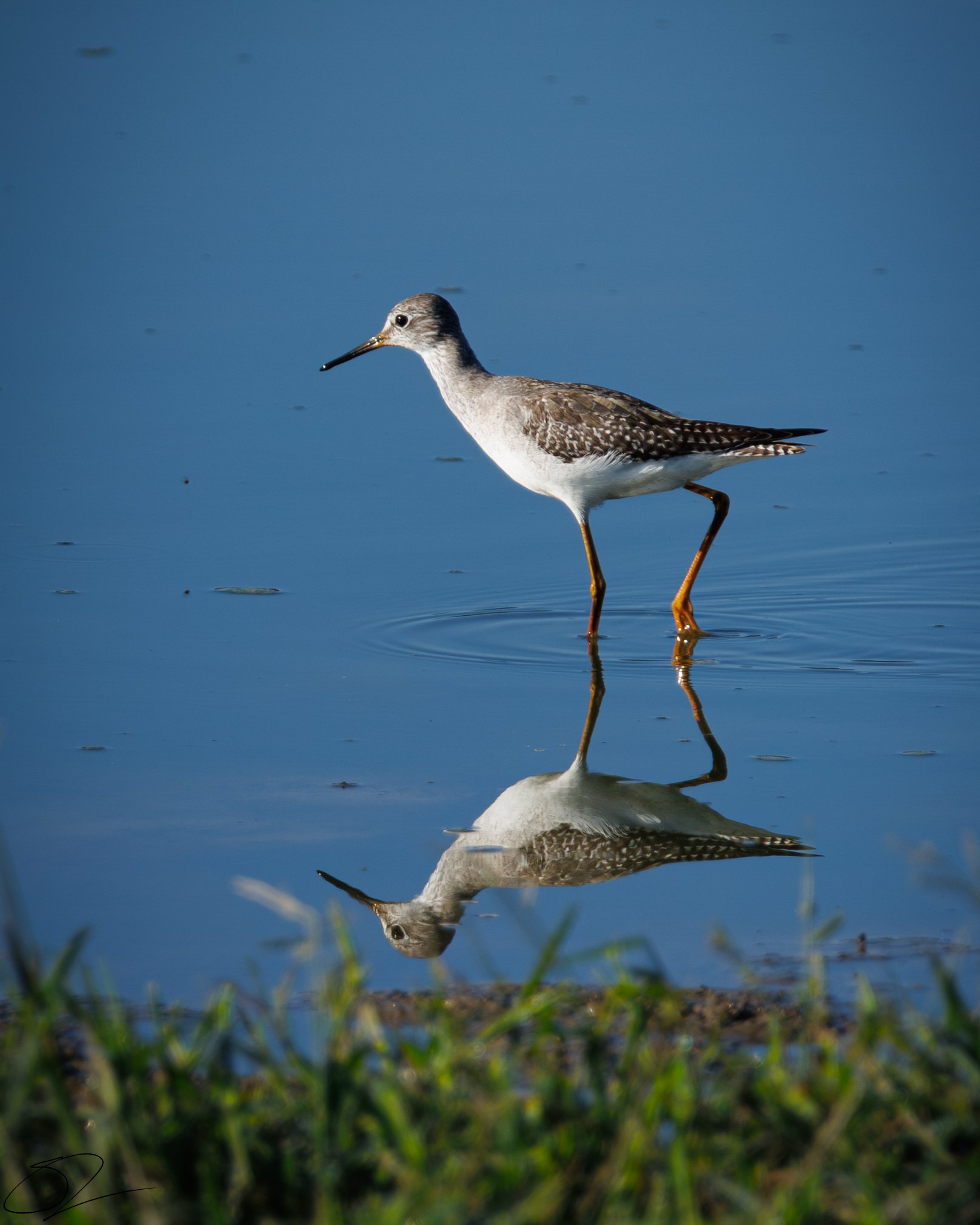
Lesser Yellowlegs ~ (Tringa flavipes) is a medium-sized shorebird known for its slender build, long bright yellow legs, and straight, thin bill. Found in wetlands, mudflats, and marshes across North America, it forages in shallow water, actively picking at insects, crustaceans, and small fish. It is similar in appearance to the Greater Yellowlegs but is smaller with a proportionally shorter bill. Lesser Yellowlegs are long-distance migrants, breeding in the boreal forests of Canada and wintering in coastal and inland wetlands of the southern U.S., Central, and South America. Their high-pitched calls and active feeding behavior make them easy to spot in wetland habitats.

Eastern Phoebe ~ (Sayornis phoebe) is a small, sturdy flycatcher found in woodlands, near water, and around human structures across eastern North America. It has a plain grayish-brown body, a pale underside, and a slightly darker head. Known for its habit of bobbing its tail, the Eastern Phoebe often perches on low branches or fences, darting out to catch flying insects. Unlike many songbirds, it frequently nests on man-made structures like bridges and buildings. It has a distinctive, raspy “fee-bee” call and is among the first migratory birds to return in early spring, signaling the change of seasons.

Stilted Sandpiper ~ (Calidris himantopus) is a medium-sized shorebird recognized by its long, slender legs and slightly curved bill. It has a grayish-brown body in nonbreeding plumage, while breeding adults display a more reddish, heavily barred pattern. Found in wetlands, mudflats, and shallow ponds, it forages by probing the water and mud for insects, small crustaceans, and aquatic invertebrates. Unlike many sandpipers, it often wades deeper into water while feeding. Stilt Sandpipers breed in the Arctic tundra and migrate long distances to wintering grounds in South America. Their elegant, deliberate movements set them apart from other similar shorebirds.

Cedar Waxwing ~ (Bombycilla cedrorum) is a sleek, elegant songbird known for its silky plumage and social behavior. It has a soft brown body that fades to gray on the wings, a pale yellow belly, a crest on its head, and a distinctive black mask across the eyes. Its wingtips often feature red, wax-like tips, and the tail ends in a bright yellow band. Cedar Waxwings are fruit specialists, often seen in flocks feeding on berries and small fruits, though they also eat insects in the summer. Found across North America, they are nomadic and may appear suddenly where food is abundant. Their high-pitched, whistled calls and graceful flight make them a favorite among birdwatchers.
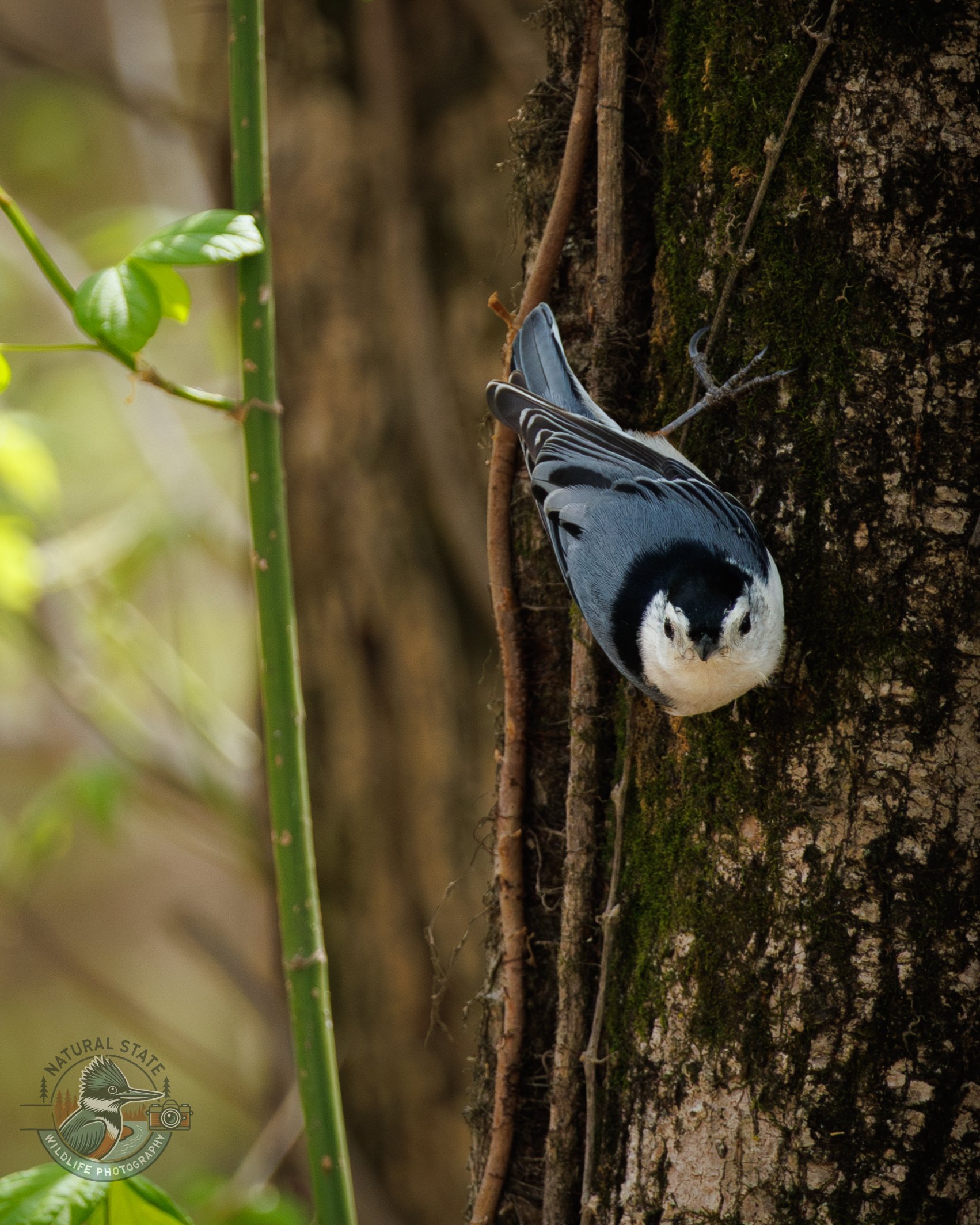
White-breasted Nuthatch ~ (Sitta carolinensis) is a small, agile songbird known for its habit of creeping headfirst down tree trunks. It has a white face and underparts, a black or dark gray cap, and blue-gray wings and back. Found in forests, woodlands, and backyard feeders across much of North America, this bird forages by probing bark crevices for insects and seeds. It often wedges food into tree bark to peck it open and may cache seeds for later. Its nasal, honking call and acrobatic movements make it a fun and familiar presence in wooded areas year-round.

Bald Eagle ~ (Haliaeetus leucocephalus) is a powerful bird of prey and the national symbol of the United States. It is easily recognized by its white head and tail, contrasting with a dark brown body and wings, and a large yellow beak. Found near large bodies of water across North America, Bald Eagles feed primarily on fish but will also eat birds, mammals, and carrion. They build enormous nests—some of the largest in the bird world—high in trees or on cliffs. Known for their soaring flight and piercing calls, Bald Eagles have made a remarkable recovery from near extinction, thanks to conservation efforts and legal protections.

Barred Owl ~ (Strix varia) is a large, round-headed owl known for its distinctive hooting call, often described as “Who cooks for you? Who cooks for you-all?” It has mottled brown and white plumage with dark eyes and horizontal barring on the chest and vertical streaks on the belly. Found in mature forests across eastern and parts of the Pacific Northwest of North America, Barred Owls are nocturnal hunters that feed on small mammals, birds, amphibians, and reptiles. They often nest in tree cavities and are known for being curious and occasionally active during the day. Their haunting calls and ghostly flight make them a memorable presence in wooded habitats.

Black-bellied Whistling-Duck ~ (Dendrocygna autumnalis) is a striking and unusual duck species found in the southern United States, Central America, and parts of South America. It has a tall, goose-like posture, with a chestnut body, black belly, gray face, and bright pink bill and legs. This highly social bird is known for its whistling call, which gives it its name. Unlike many ducks, it often perches in trees and nests in cavities or nest boxes. Black-bellied Whistling-Ducks feed on seeds, grains, and aquatic invertebrates, often foraging in shallow water or fields. Their bold appearance and vocal nature make them easy to recognize.

Double-crested Cormorant ~ (Nannopterum auritum) is a large, fish-eating waterbird found across North America in lakes, rivers, coastal bays, and estuaries. It has dark, glossy black plumage, an orange-yellow facial patch, and a long, hooked bill. During breeding season, adults display tufts of white feathers—"double crests"—on either side of the head. Unlike most waterbirds, cormorants' feathers are not fully waterproof, so they are often seen perched with wings spread to dry. Expert divers, they catch fish underwater using their powerful legs and webbed feet. Though sometimes controversial near fisheries, they play an important role in aquatic ecosystems.

Scissor-tailed Flycatcher ~ (Tyrannus forficatus) is a striking and graceful bird known for its long, forked tail—often longer than its body—that opens and closes like scissors in flight. Found mainly in the south-central United States, especially Texas and Oklahoma, it inhabits open country, prairies, and roadside fences. Males and females both sport pale gray heads and backs, salmon-pink sides, and bold black-and-white tail feathers. Agile and acrobatic, they catch insects in midair and also feed on berries. The Scissor-tailed Flycatcher is not only the state bird of Oklahoma but also a favorite among birders for its elegance and aerial displays.
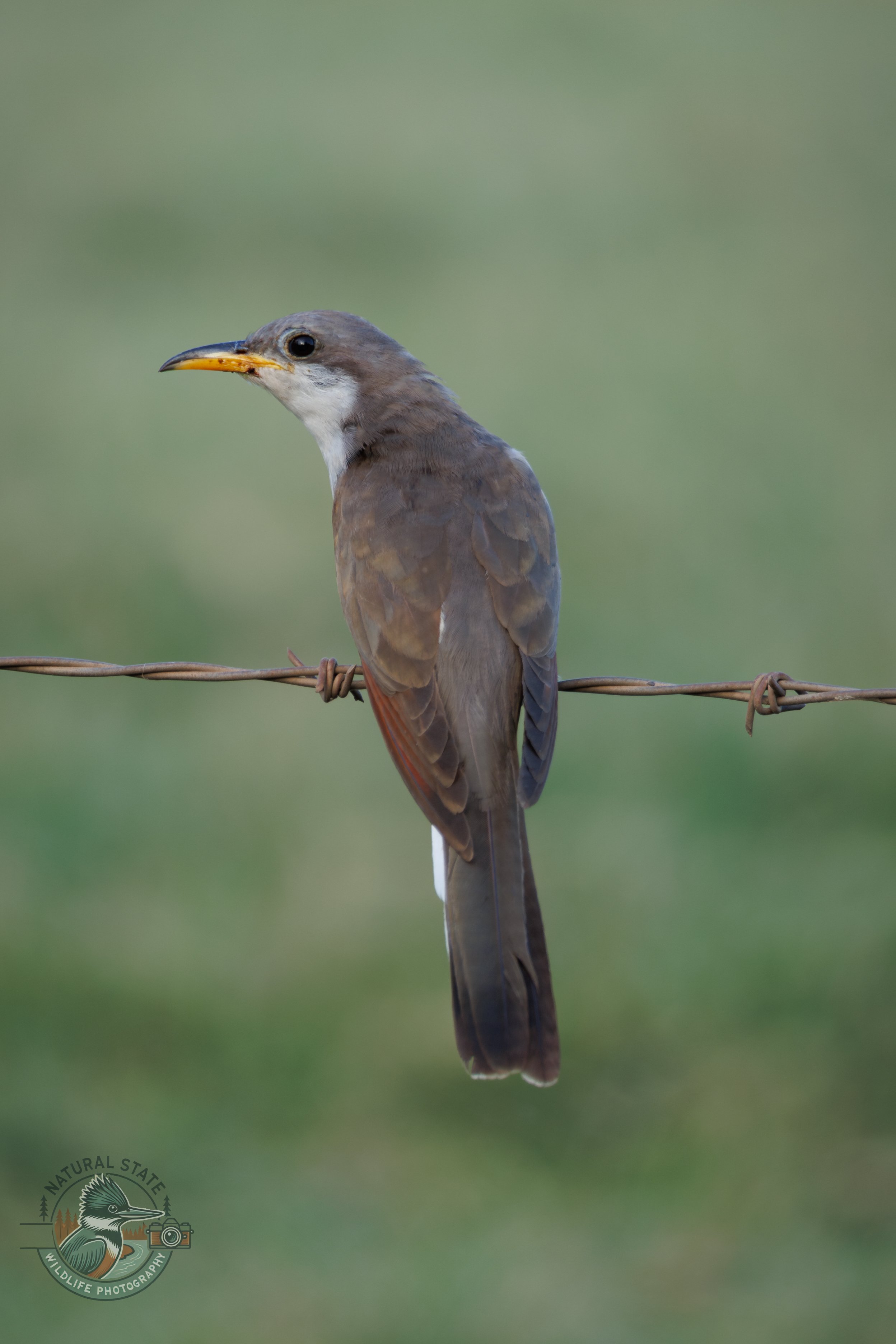
Yellow-billed Cuckoo ~ (Coccyzus americanus) is a slender, secretive bird often found in woodlands and thickets across the eastern and southwestern United States. It has a long tail with white spots underneath, a warm brown back, white underparts, and a distinctive curved bill that is yellow on the lower mandible. Sometimes called the “rain crow” due to its tendency to call more frequently before storms, its croaking, clucking calls are a familiar but elusive sound in summer forests. Yellow-billed Cuckoos feed mostly on caterpillars, including hairy species many birds avoid, as well as other insects and small fruits. They are long-distance migrants, wintering in South America.

Savannah Sparrow ~ (Passerculus sandwichensis) is a small, streaky songbird commonly found in open fields, grasslands, and coastal areas across North America. It has brown upperparts with fine streaks, a pale belly, and a distinctive yellowish patch in front of the eye. Though it may look similar to other sparrows, its short tail and crisp facial markings help with identification. Savannah Sparrows forage on the ground for seeds and insects, and their buzzy, insect-like song can often be heard during the breeding season. They nest on or near the ground and are known for their adaptability to a variety of open habitats.

Greater Yellowlegs ~ (Tringa melanoleuca) is a tall, slender shorebird known for its bright yellow legs, long neck, and slightly upturned, long bill. Found across North America, it frequents marshes, mudflats, and shallow wetlands, where it actively forages for insects, small fish, and crustaceans. Similar in appearance to the Lesser Yellowlegs, it is larger and has a noticeably longer bill. Greater Yellowlegs are energetic feeders, often seen wading through water and making quick jabs with their bill. They breed in the boreal forests of Canada and Alaska and migrate to coastal and inland areas as far south as South America during winter. Their sharp, ringing calls often echo across wetland habitats.

Brown-headed Cowbird ~ (Molothrus ater) is a small blackbird known for its unique nesting behavior—brood parasitism—where it lays its eggs in the nests of other bird species, leaving the host birds to raise its young. Males are glossy black with a rich brown head, while females are plain brown with a lighter throat and streaked underparts. Found throughout North America in open fields, forest edges, and near livestock, cowbirds often follow grazing animals to feed on insects stirred up from the ground. Though fascinating, their nesting habits can negatively impact populations of smaller songbirds, making them a complex figure in bird conservation.

Mourning Dove ~ (Zenaida macroura) is a graceful, slender bird known for its soft, sorrowful cooing call that gives it its name. Found across North America in open woodlands, fields, and suburban areas, it has light brown to grayish plumage with black spots on the wings and a long, pointed tail edged in white. Mourning Doves are strong fliers and often seen perched on wires or foraging for seeds on the ground. They are prolific breeders, often raising several broods each year. Their gentle demeanor and widespread presence make them one of the most familiar and beloved birds in North America.

Solitary Sandpiper ~ (Tringa solitaria) is a medium-sized shorebird known for its preference for inland freshwater habitats like forested ponds, creeks, and wetlands—often alone, as its name suggests. It has a dark olive-brown back speckled with white, a white eye ring, and greenish legs. Unlike many shorebirds, it nests in old songbird nests in trees rather than on the ground. Solitary Sandpipers forage by walking steadily through shallow water, picking up insects, small crustaceans, and other invertebrates. They breed in the boreal forests of Canada and migrate through much of North and Central America to wintering grounds in South America.

Western Cattle Egret ~ (Bubulcus ibis) is a small, stocky white heron known for its close association with grazing animals like cattle, often seen perching on their backs or foraging nearby for insects stirred up by hooves. Unlike most herons, it prefers grasslands, agricultural fields, and pastures over wetlands. During the breeding season, it develops buff-colored plumes on its head, chest, and back. Native to parts of Africa and Asia, the Cattle Egret has expanded its range dramatically and is now widespread across the Americas. Opportunistic and adaptable, it feeds on insects, frogs, and small vertebrates, often seen in flocks near livestock or freshly tilled fields.